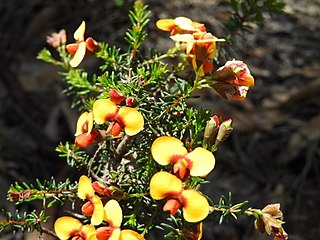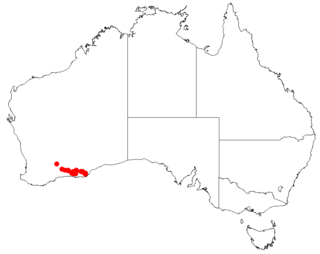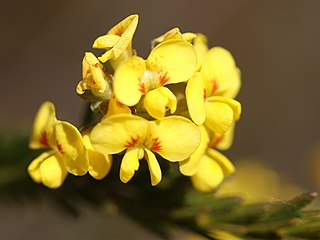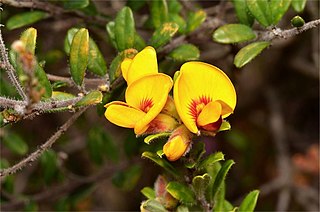
Dillwynia retorta, commonly known as eggs and bacon, is a species of flowering plant shrub in the family Fabaceae and grows in New South Wales and Queensland. It is usually an erect shrub with thin, smooth, crowded leaves and yellow flowers with red markings.

Dillwynia cinerascens, commonly known as grey parrot-pea, is a species of flowering plant in the family Fabaceae and is endemic to south-eastern Australia. It is an erect to low-lying shrub with linear or thread-like leaves and orange or yellow flowers.

Dillwynia floribunda is a species of flowering plant in the family Fabaceae and is endemic to eastern Australia. It is an erect shrub with hairy stems, crowded, grooved, linear leaves and yellow flowers with red markings.

Dillwynia phylicoides, commonly known as small-leaf parrot-pea, is a species of flowering plant in the family Fabaceae and is endemic to eastern Australia. It is an erect to open shrub with twisted, linear to narrow oblong leaves, and yellow and red flowers.

Persoonia cymbifolia is a species of flowering plant in the family Proteaceae and is endemic to the south of Western Australia. It is an erect, spreading shrub with smooth bark, hairy young branchlets, linear to narrow oblong leaves and yellow flowers borne singly or in groups of up to three on a short rachis.

Persoonia rufa is a species of flowering plant in the family Proteaceae and is endemic to the a restricted area of New South Wales. It is an erect to spreading shrub with hairy young branchlets, elliptic leaves, and yellow flowers borne in groups of up to twelve on a rachis up to 110 mm (4.3 in), each flower with a leaf at its base.

Persoonia filiformis is a species of flowering plant in the family Proteaceae and is endemic to the south-west of Western Australia. It is a small, erect shrub with hairy young branchlets, linear leaves and greenish yellow flowers borne singly or in groups of up to twenty on a rachis up to 30 mm (1.2 in) long.

Dillwynia elegans is a species of flowering plant in the family Fabaceae and is endemic to eastern New South Wales. It is an erect shrub with more or less cylindrical, grooved leaves and yellow flowers with red markings.

Dillwynia acerosa is a species of flowering plant in the family Fabaceae and is endemic to Western Australia. It is an erect spindly shrub with hairy, needle-shaped leaves and yellow flowers.

Dillwynia crispii is a species of flowering plant in the family Fabaceae and is endemic to Morton National Park in eastern New South Wales. It is an erect shrub with glabrous, linear leaves and yellow flowers with red markings.

Dillwynia glaucula, commonly known as Michelago parrot-pea, is a species of flowering plant in the family Fabaceae and is endemic to south-eastern New South Wales. It is an erect shrub with lenticels on the stems, linear, grooved leaves and yellow flowers with red markings.

Dillwynia oreodoxa is a species of flowering plant in the family Fabaceae and is endemic to Victoria, Australia. It is an erect shrub with glabrous foliage, linear leaves and yellow flowers with red markings.
Dillwynia palustris is a species of flowering plant in the family Fabaceae and is endemic to the Snowy Mountains in New South Wales. It is a weakly ascending to low-lying shrub with glabrous stems, linear, spirally twisted leaves and orange or yellow flowers with red markings.

Dillwynia prostrata, commonly known as matted parrot-pea, is a species of flowering plant in the family Fabaceae and is endemic to south-eastern continental Australia. It is a prostrate shrub with hairy stems, linear to narrow oblong or spatula-shaped leaves and yellow and dark red flowers.

Dillwynia ramosissima, commonly known as bushy parrot-pea, is a species of flowering plant in the family Fabaceae and is endemic to south-eastern continental Australia. It is a low-lying to erect shrub with linear to narrow oblong or spatula-shaped leaves and yellow flowers with red markings.

Dillwynia rudis is a species of flowering plant in the family Fabaceae and is endemic to eastern New South Wales. It is an erect shrub with warty, linear leaves and yellow to orange flowers with red veins.

Dillwynia sieberi, commonly known as Sieber's parrot-pea, is a species of flowering plant in the family Fabaceae and is endemic to eastern Australia. It is an erect shrub with rigid, needle-shaped, sharply-pointed leaves and yellow to yellow-orange flowers with reddish-brown markings.
Dillwynia stipulifera is a species of flowering plant in the family Fabaceae and is endemic to New South Wales. It is an erect to spreading shrub with hairy stems, linear leaves and yellow flowers with red markings.

Dillwynia uncinata, commonly known as silky parrot-pea, is a species of flowering plant in the family Fabaceae and is endemic to southern Australia. It is an erect, spreading shrub with cylindrical leaves and yellow flowers with a red centre.

Pultenaea tarik is a species of flowering plant in the family Fabaceae and is endemic to the Gibraltar Range National Park in New South Wales. It is an erect shrub with hairy, arching branchlets, elliptic to egg-shaped leaves with the narrower end towards the base, and yellow to orange and red to purple, pea-like flowers.

















